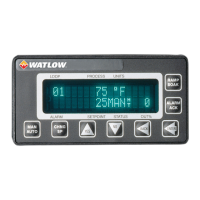CLS200 Series User’s Guide
Chapter 2: Installation
47
WATLOW ANAFAZE CLS200
LOOP
PROCESS
UNITS
ALARM
SETPOINT
STATUS
OUT%
MAN
AUTO
CHNG
SP
A
LA
RM
A
C
K
RAMP
SOAK
Y
E
S
NO
BA
CK
E
N
T
E
R
WATLOW ANAFAZE CLS200
LOOP
PROCESS
UNITS
ALARM
SETPOINT
STATUS
OUT%
M
A
N
A
U
T
O
C
H
N
G
S
P
A
L
A
R
M
A
C
K
R
A
M
P
S
O
A
K
Y
E
S
N
O
BA
CK
ENTER
Serial Port
232 Communications 485 Communications
Shielded Twisted Pair Cable
Optically
Isolating
232 to 485
First CLS200 Second CLS200 Last CLS200
Converter
WATLOW ANAFAZE CLS200
LOOP
PROCESS
UNITS
ALARM
SETPOINT
STATUS
OUT%
M
A
N
A
U
T
O
C
H
N
G
S
P
A
L
A
R
M
A
CK
R
A
M
P
S
O
A
K
Y
E
S
N
O
B
AC
K
ENTER
Figure 2.27 — Recommended System Connections
Signal Common
For usual installations, do not connect the dc commons of the controllers together or to the
converter or host device. Use an optically isolating EIA/TIA-232-to-485 converter to prevent
problems with sensor readings.
Termination
In order for EIA/TIA-485 signals to be transmitted properly, each pair must be properly terminated.
The value of the termination resistor should be equal to the impedance of the communications cable
used. Values are typically 150 to 200Ω.
The receive lines at the converter or host device should be terminated in the converter, the
connector to the host device or the device itself. Typically the converter documentation provides
instructions for termination.
Use a terminating resistor on the receive lines on the last controller on the 485 line. Set JU1 inside
the CLS200 in position B to connect a 200Ω resistor across the receive lines. Refer to Changing
Communications on page 153.
EIA/TIA-485 Converters and Laptop Computers
In order for an EIA/TIA-232-to-485 converter to optically isolate the computer from the 485 network,
the 232 and 485 sides must be powered independently. Many 232-to-485 converters can be
powered by the computer’s communications port. Some computers, laptops in particular, do not
automatically provide the appropriate voltages. These computer/ converter combinations can usually
be used by connecting an external power supply to the 232 side of the converter. Not all converters
have power inputs for the 232 side, however.

